
MACRO: 4 Reasons This Bull Market Still Has Legs
This rally’s been epic. The S&P 500 is up 10% in 2024 on top of 2023’s impressive 26.2% total return.
Our macro message for investors (not traders) remains the same: stay the course. This broadening rally has plenty of gas left in the tank.
Today, we’ll discuss 4 reasons this bull market still has legs.
Remember, bull markets are born on despair, mature on skepticism, bloom on acceptance, and finally die on euphoria. This time-tested behavioral evolution takes an average of four years to play out.
This bull market began in October 2022. It’s only middle-aged.
In early April, we told you strong momentum isn’t a reason to sell stocks. Sure enough, after a healthy 6% pullback, stocks are back near new all-time highs.
That’s sending Wall Street strategists into scramble mode to raise their yearend targets for the S&P 500. The average price target is still just 5,100. Such widespread caution signals euphoria is still a long way off.
Today we’ll dive into interest rates, inflation, earnings, and valuation. There’s a ton to be constructive about.
Then we’ll show you the sectors with the most upside as this broadening bull market keeps powering higher.
4 Reasons This Bull Market Still Has Legs
This bull market’s been “Teflon coated.” Nothing’s been able to derail it. Except for one thing.
Rising interest rates have been the stock market’s kryptonite over the past 18 months. Every time rates have pushed meaningfully higher, stocks have wobbled (chart).
That’s reason number 1 to stay invested.
Inflation’s been falling steadily since 2022, but not in a straight line. Service sector inflation has been sticky. Whenever inflation ticked up, rates rose in anticipation of delayed Federal Reserve rate cuts.
Higher rates are bad news for stocks for a couple of key reasons:
- Rising interest rates are a tax on the economy – they make it more expensive for companies to do business and for consumers to spend. That hurts corporate earnings.
- Higher yields also make bonds and money markets more attractive, siphoning money out of stocks.
Note below how when the 10-year Treasury yield rises, stocks fall. When yields collapse, equities surge:

We’re bullish on equities because we’re confident inflation will continue to fall. It’s just a matter of time before the Fed starts easing monetary policy. That should keep interest rates in check.
History also supports a stable interest rate outlook.
What the rate bears miss is that long-term yields have historically been stable when inflation is running between 2% and 4%, as it is now.
Reason number 2 to keep owning high-quality equities is simply due to rates likely staying under control.
Check it out in this chart. Inflation needs to exceed 6% before we see lasting jumps in 10-year bond yields. Think 2022 when rates soared with CPI inflation peaking at 9.1%.
Equities traded poorly back then – today isn’t the same uncertain environment.
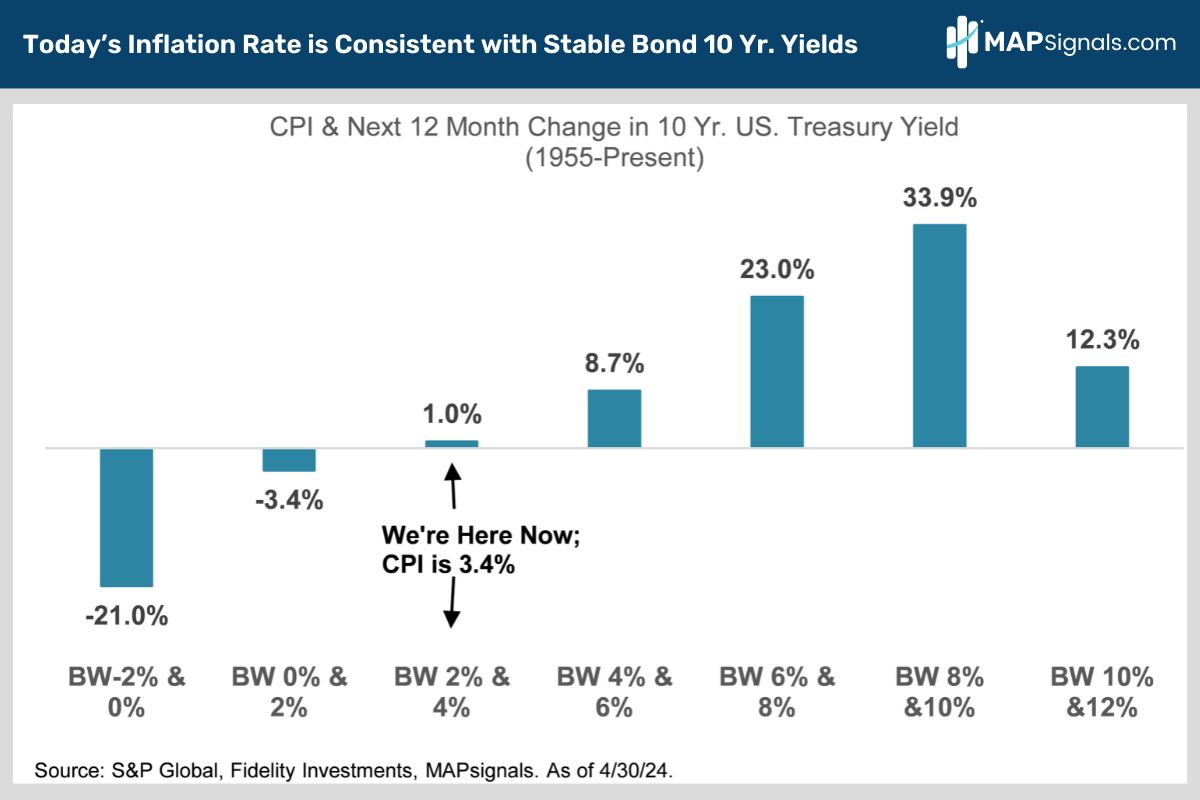
OK, so the inflation and interest rate outlooks are likely to remain bullish for stocks, let’s shift gears to check on the other big macro driver of stock prices: corporate earnings.
Reason number 3 to feel bad for the bears is due to rising corporate earnings.
In the wake of 2023’s shallow earnings recession, S&P 500 12-month forward per-share earnings growth has ramped up to 12% after a better-than-expected first quarter earnings season:
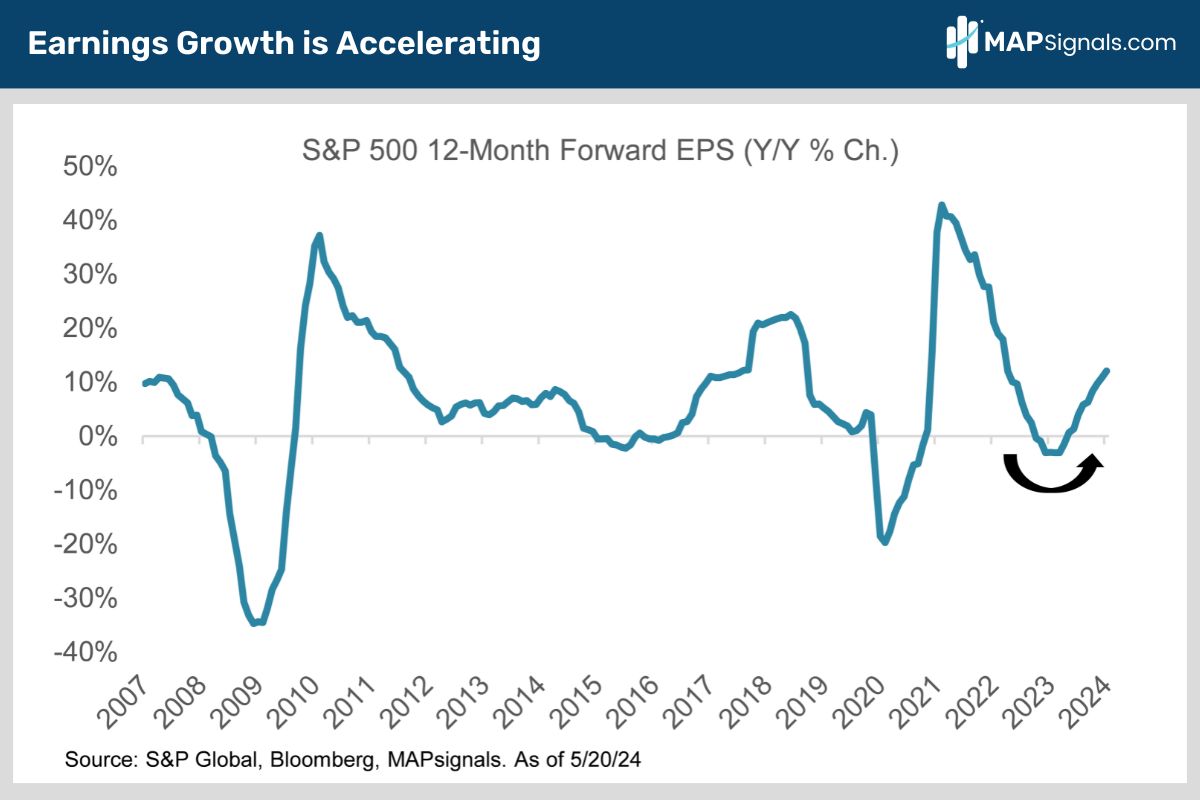
When earnings are improving, stock prices follow suit.
OK, so fundamentals are improving. But what about valuations?
Large-cap growth valuations are elevated thanks to big technology companies’ amazing profitability. As for the rest of the stock market, earnings are ramping up, but valuations are still reasonable relative to history, as this chart shows.
Relative value can be found in the S&P SmallCap 600 and S&P 500 Equal Weight indices.
Reason number 4 I’m constructive on stocks is because there is value under the surface.
These reasonable valuations are why we’re finding lots of outliers experiencing Big Money buying outside of big tech.
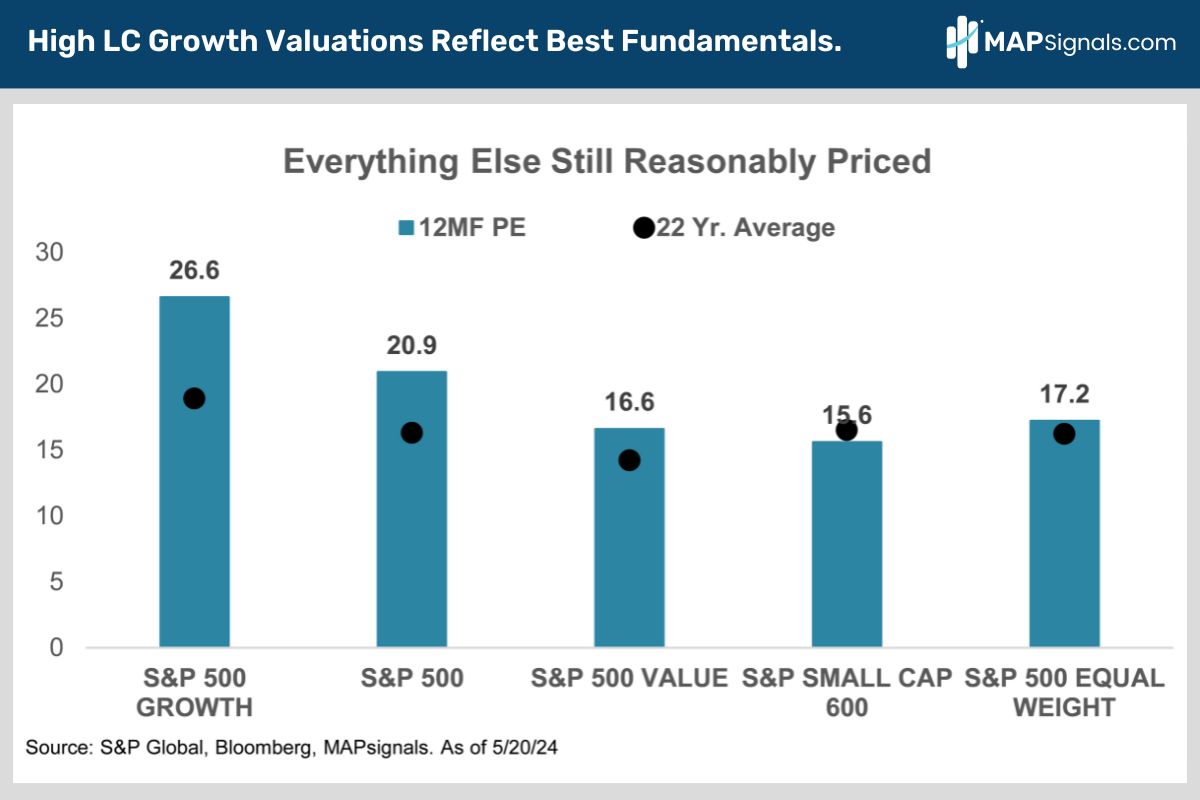
OK so the macro environment is likely to remain supportive for stocks. And our North Star, the Big Money Index (BMI) agrees.
The BMI is a fantastic timing tool. It tracks institutional investor positioning. Subscribers know we’ve been nailing market pivot points with it for years.
Here’s how the BMI works:
Readings under 30% are rare, indicating stocks are oversold and it’s time to buy. Conversely, readings over 80% mean stocks are overbought and traders should lighten up once the indicator heads south.
The BMI rightly said to buy stocks in October 2022 at the bear market bottom when it went oversold at 25%. It also nailed last July’s peak, showing it was time to sell stocks when it went overbought at 84%.
Then the BMI slumped down to a super-low 17% last October. It rightly said to buy as stocks were bottoming out. The S&P 500 is up over 29% since its low of 4,103 on Oct. 27.
The BMI helps us spot powerful inflection points.
Here’s the BMI’s latest: it recently swooned from 75% to 45%. A decline this steep, this fast is rare. When the bottom falls out, capitulation is usually right around the corner.
Sure enough, since bottoming in mid-May, the BMI started rebounding sharply as outflows are finally being overpowered by fresh capital being put to work.
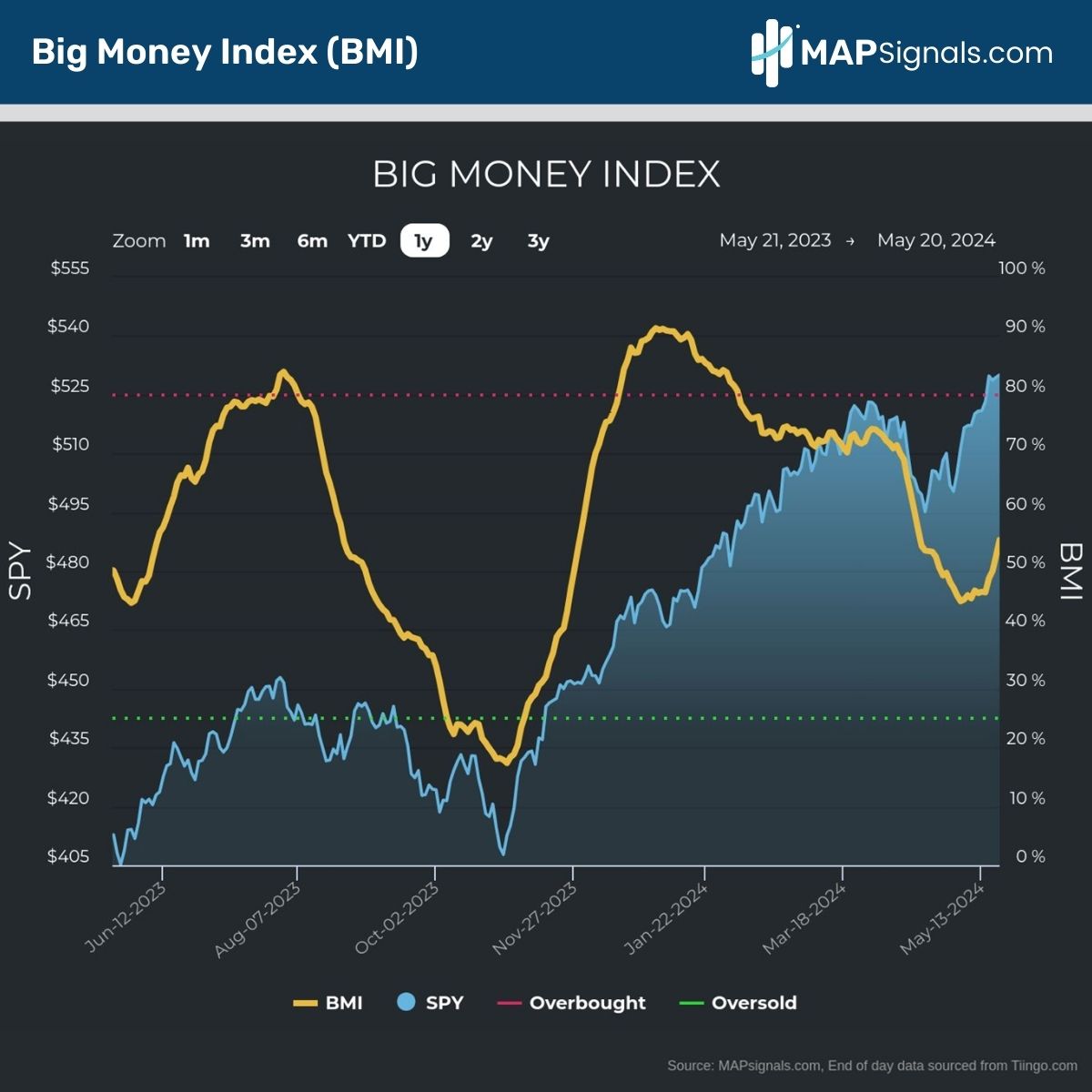
Stop being fearful and start getting cheerful.
What This Means for Your Portfolio
The biggest takeaway is to stay long stocks. We know it’s tempting to take profits after this monster run. Don’t do it. This broadening rally has plenty of gas left in the tank.
In January, we told you Macro Drivers Signal a Broadening Rally in 2024.
Sure enough, we’ve got an “everything rally” on our hands. Almost every sector is posting healthy gains:
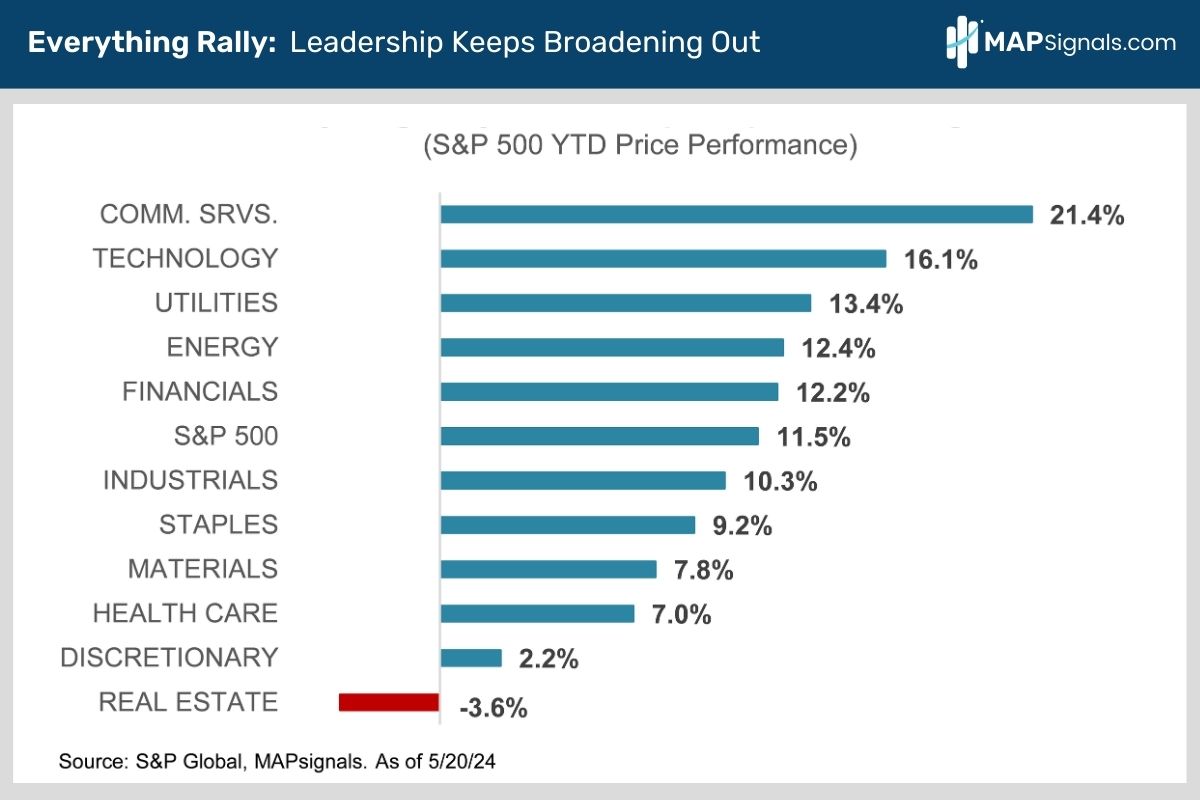
Cyclicals and tech continue to do well. It’s also notable how utilities surged to third in anticipation of an AI-driven increase in nationwide electricity demand.
Outside of real estate and discretionary, both of which have been held back by elevated interest rates and a sluggish lower-income consumer, every sector is doing well.
Lots of cyclical mid- and small-cap outliers are seeing Big Money buying. Their earnings are finally ramping up while valuations are still reasonable.
We continue to like energy, industrials, and financials stocks. Check out how these sectors continue to top MAPsignals’ sector rankings:
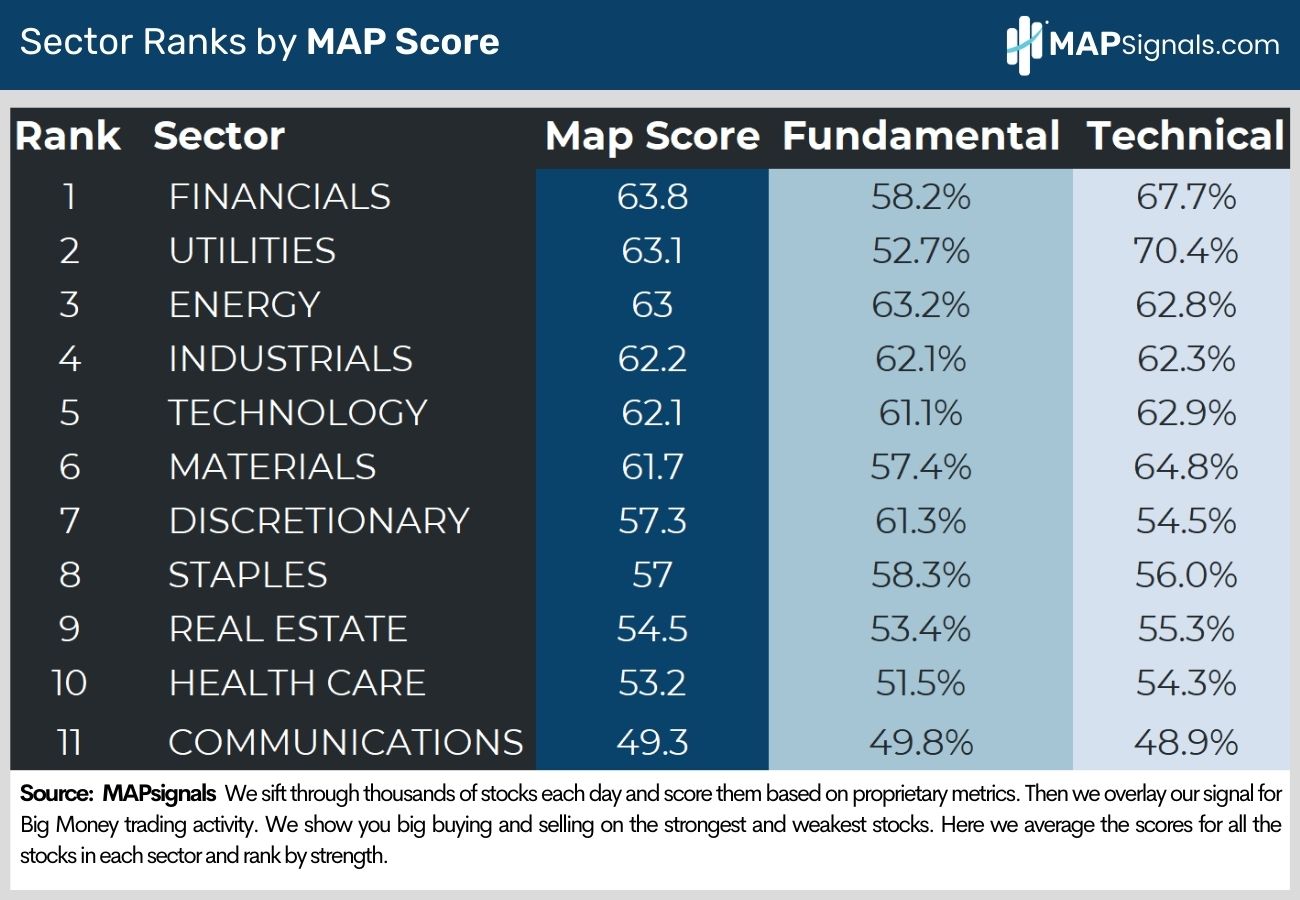
Let’s say it again. The macro and money flow picture provide 4 reasons the bull market still has legs.
Here’s the bottom line: This bull market’s been “Teflon coated.” Nothing’s been able to derail it except for occasional bouts of rising interest rates.
We’re confident inflation will continue to fall. It’s just a matter of time before the Fed starts easing monetary policy. That should keep rates in check.
In the wake of 2023’s shallow earnings recession, S&P 500 12-month forward earnings growth has ramped up to 12% on the heels of a great first quarter earnings season.
As for valuations, large-cap growth is rich thanks to big tech’s amazing profitability. Earnings are ramping up for the rest of the market, but valuations are still reasonable relative to history.
Lastly, the BMI agrees with all this. After a sharp springtime swoon, it’s rebounding as outflows are finally being overpowered by fresh capital being put to work.
That’s a powerful 1, 2 punch!
It’s no surprise MAPsignals is finding lots of cyclical and small-cap outliers right now. Fundamentals are improving while valuations remain cheap.
If you want to find specific large-, mid-, and small-cap energy, financials, and industrials stocks ramping with Big Money support, get started with a MAPsignals PRO subscription. It’ll get you access to our portal that updates every morning, showcasing the exact tickers being bought and their scores.
Tomorrow’s leading stocks can be found today. Our prized Top 20 list is full of cyclical market beaters.
There are plenty of winning stocks seeing Big Money inflows as the market broadens out. If you’re a Registered Investment Advisor (RIA) or a serious investor, use a MAP to find them!
Invest well,
-Alec
